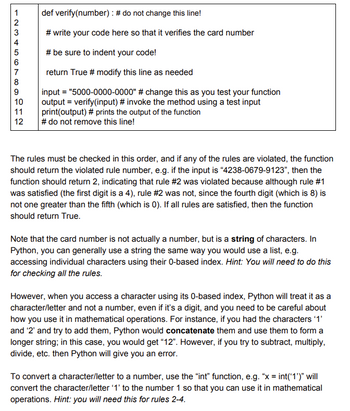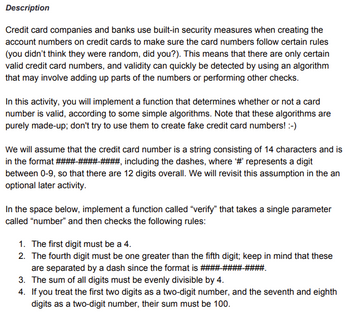
Database System Concepts
7th Edition
ISBN: 9780078022159
Author: Abraham Silberschatz Professor, Henry F. Korth, S. Sudarshan
Publisher: McGraw-Hill Education
expand_more
expand_more
format_list_bulleted
Concept explainers
Question

Transcribed Image Text:12345678
9
10
11
12
def verify(number)
: # do not change this line!
#write your code here so that it verifies the card number
# be sure to indent your code!
return True # modify this line as needed
input = "5000-0000-0000" # change this as you test your function
output = verify(input) # invoke the method using a test input
print(output) # prints the output of the function
# do not remove this line!
The rules must be checked in this order, and if any of the rules are violated, the function
should return the violated rule number, e.g. if the input is "4238-0679-9123", then the
function should return 2, indicating that rule #2 was violated because although rule #1
was satisfied (the first digit is a 4), rule #2 was not, since the fourth digit (which is 8) is
not one greater than the fifth (which is 0). If all rules are satisfied, then the function
should return True.
Note that the card number is not actually a number, but is a string of characters. In
Python, you can generally use a string the same way you would use a list, e.g.
accessing individual characters using their 0-based index. Hint: You will need to do this
for checking all the rules.
However, when you access a character using its 0-based index, Python will treat it as a
character/letter and not a number, even if it's a digit, and you need to be careful about
how you use it in mathematical operations. For instance, if you had the characters '1'
and '2' and try to add them, Python would concatenate them and use them to form a
longer string; in this case, you would get "12". However, if you try to subtract, multiply,
divide, etc. then Python will give you an error.
To convert a character/letter to a number, use the "int" function, e.g. "x = int('1')" will
convert the character/letter '1' to the number 1 so that you can use it in mathematical
operations. Hint: you will need this for rules 2-4.

Transcribed Image Text:Description
Credit card companies and banks use built-in security measures when creating the
account numbers on credit cards to make sure the card numbers follow certain rules
(you didn't think they were random, did you?). This means that there are only certain
valid credit card numbers, and validity can quickly be detected by using an algorithm
that may involve adding up parts of the numbers or performing other checks.
In this activity, you will implement a function that determines whether or not a card
number is valid, according to some simple algorithms. Note that these algorithms are
purely made-up; don't try to use them to create fake credit card numbers! :-)
We will assume that the credit card number is a string consisting of 14 characters and is
in the format #### #### ####, including the dashes, where '#' represents a digit
between 0-9, so that there are 12 digits overall. We will revisit this assumption in the an
optional later activity.
In the space below, implement a function called "verify" that takes a single parameter
called "number" and then checks the following rules:
1. The first digit must be a 4.
2. The fourth digit must be one greater than the fifth digit; keep in mind that these
are separated by a dash since the format is ####-####-
3. The sum of all digits must be evenly divisible by 4.
4. If you treat the first two digits as a two-digit number, and the seventh and eighth
digits as a two-digit number, their sum must be 100.
Expert Solution
This question has been solved!
Explore an expertly crafted, step-by-step solution for a thorough understanding of key concepts.
This is a popular solution
Trending nowThis is a popular solution!
Step by stepSolved in 3 steps with 2 images

Knowledge Booster
Learn more about
Need a deep-dive on the concept behind this application? Look no further. Learn more about this topic, computer-science and related others by exploring similar questions and additional content below.Similar questions
- You are awesome! Could you do these too please? Q4: Create a function that multiply's two numbers together and outputs the answer. The function must accept 2 parameters. Don't forget about SCOPE if you're using varibles inside of your function. Q5: Using your multiply function, use the shortest amount of code to display the following output on the screen: 1 * 1 = 1 2 * 2 = 4 3 * 3 = 9 4 * 4 = 16 5 * 5 = 25 6 * 6 = 36 7 * 7 = 49 8 * 8 = 64 9 * 9 = 81 10 * 10 = 100 Q6: Determine using a conditional statement, if the following variable is a number or is not not a number. If it is not, try to convert it to a number and use your mult() function to multiply it by 2. NOTE: YOU MAY NOT MODIFY ANY VARIBLES that are Constants. const number = "17";arrow_forwardPYTHON Question 3: Rain or Shine Part 1: Alfonso will only wear a jacket outside if it is below 60 degrees or it is raining. Write a function that takes in the current temperature and a boolean value telling if it is raining and it should return True if Alfonso will wear a jacket and False otherwise. Try solving this problem with a single line of code. def wears_jacket(temp, raining): """ >>> wears_jacket(90, False) False >>> wears_jacket(40, False) True >>> wears_jacket(100, True) True """ *** YOUR CODE HERE *** Note that it should either return True or False based on a single condition, whose truthiness value will also be either True or False. Part 2: Rewrite the above function with a lambda expression.arrow_forwardFinish the function below that takes in the length of the two parallel sides of a trapezoid a and b, which are separated by a distance h, and returns its area. In [ ]: defarea_of_trapezoid(a,b,h):# YOUR CODE HEREraiseNotImplementedError() In [ ]: """Check that area_of_triangle returns the correct output for several inputs""" assert abs(area_of_trapezoid(3,3, 5) - 15) <=.1 assert abs(area_of_trapezoid(3,4, 5) - 17.5)arrow_forward
- When passing a variable to a function how should the variable be passed? a. Variables can't be passed to functions b. Either ByVal or ByRef (it doesn't matter) c. ByVal d. ByRefarrow_forward//Write a function that loops through and console.log's the numbers from 1 to 100, except multiples of three, log (without quotes) "VERY GOOD" instead of the number, for the multiples of five, log (without quotes) "SUPER AWESOME". For numbers which are multiples of both three and five, log (without quotes) "VERY GOOD SUPER AWESOME" Console log out: 12VERY GOOD4SUPER AWESOMEVERY GOOD78VERY GOODSUPER AWESOME11VERY GOOD1314VERY GOOD SUPER AWESOME1617VERY GOOD19SUPER AWESOMEVERY GOOD2223VERY GOODSUPER AWESOME26VERY GOOD2829VERY GOOD SUPER AWESOMEarrow_forwardConsider the following incomplete code: def f(number): # missing function body print(f(5)) The missing function body should be Select one: a. return "number" O b. return number O c. return O d. print (number)arrow_forward
- What is the return value of a function that doesn't specify a return statement or simply has an empty return statement? Example: def x(a,b): print(x) returnarrow_forwardPlease tell me where I get wrong.arrow_forwardIn C++ i need the fill in the functions that will complete this code for the program to work.arrow_forward
- Functions like print which perform an action but don’t return a value are called: Select one: a. recursive functions b. built-in functions c. simple functions d. utility functions e. void functionsarrow_forwardComplete the following Codearrow_forwarddef square(x): return x * X def halve(x): return x // 2 def twice(f,x): """Apply f to the result of applying f to x >>> twice (square,3) 81 >>> twice (square, 4) 256 >>> twice (halve, 32) 8 >>> twice (halve, 80) 20 *** YOUR CODE HERE ***"arrow_forward
arrow_back_ios
SEE MORE QUESTIONS
arrow_forward_ios
Recommended textbooks for you
 Database System ConceptsComputer ScienceISBN:9780078022159Author:Abraham Silberschatz Professor, Henry F. Korth, S. SudarshanPublisher:McGraw-Hill Education
Database System ConceptsComputer ScienceISBN:9780078022159Author:Abraham Silberschatz Professor, Henry F. Korth, S. SudarshanPublisher:McGraw-Hill Education Starting Out with Python (4th Edition)Computer ScienceISBN:9780134444321Author:Tony GaddisPublisher:PEARSON
Starting Out with Python (4th Edition)Computer ScienceISBN:9780134444321Author:Tony GaddisPublisher:PEARSON Digital Fundamentals (11th Edition)Computer ScienceISBN:9780132737968Author:Thomas L. FloydPublisher:PEARSON
Digital Fundamentals (11th Edition)Computer ScienceISBN:9780132737968Author:Thomas L. FloydPublisher:PEARSON C How to Program (8th Edition)Computer ScienceISBN:9780133976892Author:Paul J. Deitel, Harvey DeitelPublisher:PEARSON
C How to Program (8th Edition)Computer ScienceISBN:9780133976892Author:Paul J. Deitel, Harvey DeitelPublisher:PEARSON Database Systems: Design, Implementation, & Manag...Computer ScienceISBN:9781337627900Author:Carlos Coronel, Steven MorrisPublisher:Cengage Learning
Database Systems: Design, Implementation, & Manag...Computer ScienceISBN:9781337627900Author:Carlos Coronel, Steven MorrisPublisher:Cengage Learning Programmable Logic ControllersComputer ScienceISBN:9780073373843Author:Frank D. PetruzellaPublisher:McGraw-Hill Education
Programmable Logic ControllersComputer ScienceISBN:9780073373843Author:Frank D. PetruzellaPublisher:McGraw-Hill Education

Database System Concepts
Computer Science
ISBN:9780078022159
Author:Abraham Silberschatz Professor, Henry F. Korth, S. Sudarshan
Publisher:McGraw-Hill Education

Starting Out with Python (4th Edition)
Computer Science
ISBN:9780134444321
Author:Tony Gaddis
Publisher:PEARSON

Digital Fundamentals (11th Edition)
Computer Science
ISBN:9780132737968
Author:Thomas L. Floyd
Publisher:PEARSON

C How to Program (8th Edition)
Computer Science
ISBN:9780133976892
Author:Paul J. Deitel, Harvey Deitel
Publisher:PEARSON

Database Systems: Design, Implementation, & Manag...
Computer Science
ISBN:9781337627900
Author:Carlos Coronel, Steven Morris
Publisher:Cengage Learning

Programmable Logic Controllers
Computer Science
ISBN:9780073373843
Author:Frank D. Petruzella
Publisher:McGraw-Hill Education